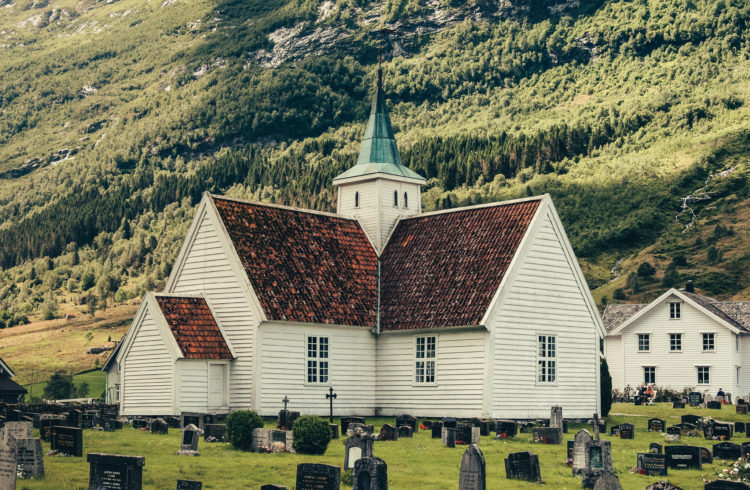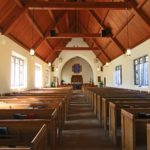I sat on stage for what felt like a funeral.
Except there was no remains. No ashes. No person had died, actually.
But something had died—somethings, in the plural, if you’d dare call them “things.” They used to have bodies too. And their pictures were shown on screens, with years in parentheses listed towards the bottom.
These were churches.
A Church Funeral
“Closed” was the official language that was used as each name was read and the proceedings of their surviving members and possessions were described in front of the clergy and laity gathered together for the annual conference of the denomination which I serve.
Ten.
Ages ranging from several hundred years to less than one hundred. But they were all representative of times gone by, lives gone by, ministries that had ended.
I observed from my spot at the back of the stage. At the end of the funeral, I was asked to stand from my seat, along with several other pastors, to represent the other end of the church life cycle– birth. We were the planters—the representatives of new birth, the babies of the church world. It was death and new life, juxtaposed within minutes.
But nobody clapped for the dead churches—only the new ones.
And as I stood, the biologist’s mind in me began to kick in. And I began to wonder something I had never wondered before.
I began to wonder if ministry is healthiest when observed in life cycles. I began to wonder if that meant it wasn’t only acceptable, but rather necessary—and even healthy– for churches to die.
Like trees. But nobody clapped for the dead churches—only the new ones. Click To Tweet
The Rise of the Forest
What if we saw the ministry of a local church not as a never-ending story but as a life cycle? How would that change where we invest ourselves, our resources, and ultimately live our God’s mission in an ever-changing world? Could there be more births? Could there be a healthier church forest?
After all, every church once began as a church plant.
Every church, every ekklesia that ever was and is and ever shall be is conceived by human beings as a means of sharing the gospel. In the first and second centuries, a group of people came to faith and began meeting in someone’s house.
Historically, in newly settled towns, Christians invited their neighbors and gathered to start a church. Missionaries shared the gospel with indigenous people and started to meet with them regularly. Denominations attempted to establish parishes that delineate who belongs to which. Brick, mortar, wood, mud, cinderblock, and other materials rose to the occasion of creating distinguished spaces and mission centers for these churches to operate. Soon, what had been an open field soon was dotted with these Christ-centered communities that would change the areas where they took root.
Different denominations arrived, sometimes coming into competition with their neighbors. Marking the landscape as seedlings, some grew and others expanded. Some even moved; they were transplanted from one location to another, where they could grow better or where their members wanted them. As a result, the forest of churches grew, and additional seeds were scattered.
It looked like a healthy landscape of greenery.
But as churches aged like trees and the environment changed, things took a turn.
Over time, the churches matured. As the new churches filled the understory, the canopy grew thicker and thicker, blocking those underneath from growing at all. At first, the young ones grew rapidly, spreading roots and branches far into the community, there were soon bare limbs that served little purpose other than blocking the light and letting other groups in the area use them simply to gather and build their own nests. Some trees continued to survive by living off their stores of energy. Some were knocked down, completely plowed over because they were seemingly irrelevant and unnecessary for what the people who lived there wanted to do. The forest turned into a place for periodic weekend excursions and short-term camping trips.
Perhaps the reason why most of us have a difficult time thinking of ministry and churches in life cycles is that we’ve focused so much on structure, as opposed to function. While buildings and ministry centers have given the Church presence on the landscape and in culture, they have also subconsciously given us a mentality of permanence and preservation instead of adaptation and rhythm. In a similar way, we often think of trees not as living things but rather as structures that provide shade, beauty, fruit, and weekend hikes. We have a hard time when we see a forest struck by lightning and then undergo natural evolution and transition back to a meadow, when that’s what’s supposed to happen.
Seeking to preserve the forest at the expense of healthy trees can leave a mass of wooden structures, but little life. Preserving the forest at the expense of healthy trees can leave wooden structures, little life. Click To Tweet
Different Lifespans
Prolonging the life of any organism past its lifespan can actually be detrimental to itself and future generations. When ministry is understood in life cycles, death is not meant to be feared but is taken as a part of life Sometimes the shorter lifespan actually produces the most fruit.
For example, age ranges for trees depend on species, location, and adaptations. But the life span of a tree is actually inversely correlated to the amount of fruit it produces. Trees known for their fruit do not have a long life span compared to other tree types; apple trees have life spans of 35-45 years, while plum and cherry trees have average life spans of 15-20 years and peach trees have one of the shortest life spans of fruit trees, averaging 10-15 years. Keeping a tree alive beyond that time would be fruitless.
Other species, like coniferous trees, retain their foliage all year long and tend to live between 150 and 450 years. Deciduous trees, like oaks, ashes, and beeches, are those that shed their leaves each autumn and sprout new ones each spring. They usually live between 300 and 400 years. There are some species like the Giant Redwood that live for an extremely long time– averaging 1,250-2,200 years.
While there are churches and trees around the world that date back to the first few hundred years of Christianity, most individual local communities that had been planted long ago no longer exist—though their progeny do. The key to survival most always becomes transformation and multiplication. Most gave birth to others that carried on the faith or transformed as people moved across continents and around the world. The ones that did not ended up as structures, museums, and tourist sites.
How would it change the way we plant churches and what we try to make older congregations do if we recognized the reality that most churches only remain prodigiously fruitful for a number of years? Could it be that older churches should be enabling the planting of new churches vs. resurrecting tired ministries? Could it be that keeping a tree alive too long is actually counter-productive to its design and continuation of its kind? How would we plant churches if we recognized they'd only remain fruitful for a number of years? Click To Tweet
Premature Death
Of course, while a tree may have a certain lifespan, different factors can contribute to an untimely death for any species, in any location, in any time. The same is true for churches; the realization of church life cycles is not a means of excusing lethargy or early demise. External forces like winds, fires, floods, and drought can mean destruction for trees, just as facilities, financial issues, and a disconnected neighborhood can cause problems for churches.
Those who suffer the most, who are unable to recover, are usually the weakest, least-adaptable, and have the shallowest roots in their communities. A church that blames what’s going on in society without adapting its form will continue to face ill effects and, in time, demise before its time. In addition, internal issues, such as pests and disease can also weaken and cause the tree to deteriorate. Some forces may be localized. In the same way, a church with unhealthy behaviors, pastoral dependencies, and inflexibility also sets itself up for premature aging and premature death. Some of the time, the effects are irreversible. Catching the disease, the fire, or the strain early and not being afraid to face it head-on is the only way to prevent early decline.
Of Churches and of Trees
“Very truly I tell you, unless a kernel of wheat falls to the ground and dies, it remains only a single seed. But if it dies, it produces many seeds” -John 12:24.
Jesus knew the necessity of life cycles. He knew that life and death were indeed connected, intertwined, and mutually dependent. Staying alive for one’s own sake would mean not only missing out on a new, different form of life but also multiplication of the Kingdom. Perhaps the same goes for our churches.
While this doesn’t mean plowing down and purposely wiping out the frontier of established congregations, this does mean rethinking our efforts to prolong life at the expense of birth. In a day and age when the Church is figuring out a new identity in a new and changing landscape we’ve never seen, the last thing we should do is seek to stop the life cycle. Old church buildings, properties, endowments, and mission fields can even be stewarded in a way for new churches to spring to life in ways, places, and forms that never would have been possible.
What if we need to abandon our fear of death and instead embrace our place in the life cycle of ministry and the opportunities that come with it?
What if death could mean more life– new life?
Kind of sounds like Jesus. Staying alive for one's own sake means only missing out on new life and Kingdom multiplication. Click To Tweet






Missio Alliance Comment Policy
The Missio Alliance Writing Collectives exist as a ministry of writing to resource theological practitioners for mission. From our Leading Voices to our regular Writing Team and those invited to publish with us as Community Voices, we are creating a space for thoughtful engagement of critical issues and questions facing the North American Church in God’s mission. This sort of thoughtful engagement is something that we seek to engender not only in our publishing, but in conversations that unfold as a result in the comment section of our articles.
Unfortunately, because of the relational distance introduced by online communication, “thoughtful engagement” and “comment sections” seldom go hand in hand. At the same time, censorship of comments by those who disagree with points made by authors, whose anger or limited perspective taints their words, or who simply feel the need to express their own opinion on a topic without any meaningful engagement with the article or comment in question can mask an important window into the true state of Christian discourse. As such, Missio Alliance sets forth the following suggestions for those who wish to engage in conversation around our writing:
1. Seek to understand the author’s intent.
If you disagree with something the an author said, consider framing your response as, “I hear you as saying _________. Am I understanding you correctly? If so, here’s why I disagree. _____________.
2. Seek to make your own voice heard.
We deeply desire and value the voice and perspective of our readers. However you may react to an article we publish or a fellow commenter, we encourage you to set forth that reaction is the most constructive way possible. Use your voice and perspective to move conversation forward rather than shut it down.
3. Share your story.
One of our favorite tenants is that “an enemy is someone whose story we haven’t heard.” Very often disagreements and rants are the result of people talking past rather than to one another. Everyone’s perspective is intimately bound up with their own stories – their contexts and experiences. We encourage you to couch your comments in whatever aspect of your own story might help others understand where you are coming from.
In view of those suggestions for shaping conversation on our site and in an effort to curate a hospitable space of open conversation, Missio Alliance may delete comments and/or ban users who show no regard for constructive engagement, especially those whose comments are easily construed as trolling, threatening, or abusive.